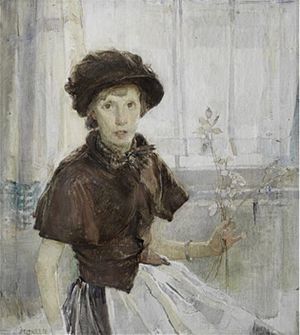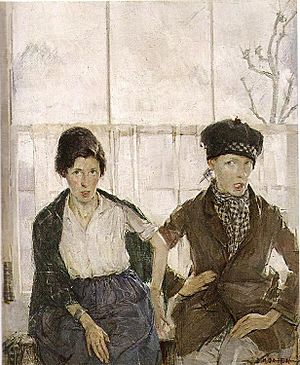Madeline Green facts for kids
Quick facts for kids
Madeline Green
|
|
|---|---|

Madeline Green, Self-Portrait painting Honesty (Private collection)
|
|
| Born |
Madeline Emily Green
27 August 1884 Craven Road, Paddington, London
|
| Died | 17 February 1947 (aged 62) Norwich, Norfolk, England
|
| Nationality | British |
| Education | Royal Academy of Arts |
| Known for | Figurative artist |
Madeline Emily Green (1884–1947) was a talented British artist. She was known for her figurative art, which means she painted people and objects in a realistic way. Her work was shown in many important places. These included the Royal Academy of Arts in London, the Society of Women Artists, and the Society of Graphic Art. Her paintings were also displayed in other galleries across Great Britain and in other countries.
Contents
Who Was Madeline Green?
Early Life and Training
Madeline Green was born in London on August 27, 1884. Her parents were Emily Laura and Frederick John Green. Frederick was a butcher and farmer. Madeline was one of five children, with one brother and four sisters.
When she was about five years old, her family moved to Ealing, a part of London. From the age of nine, Madeline and her sisters attended Princess Helena College.
Madeline studied art at the Royal Academy of Arts in London. She was there from 1906 to 1911. This was a very important art school. In 1911, she won two special medals from the Royal Academy. One was a silver medal and £25 for a drawing of a draped figure. The other was a bronze medal for a painting of a head. After her studies, Madeline set up her own art studio.
Moving Around
In the early 1940s, Madeline had to move from her home in Ealing. The government needed her house. She then lived in different places in England, including Lincolnshire and Norfolk.
In 1943, Madeline and her sister Gladys lived together in Sloley, Norfolk. Madeline passed away in a hospital in Norfolk on February 17, 1947, when she was 62 years old. Her sister Gladys was very important to her career. Gladys helped manage her affairs and organized her art shows. This allowed Madeline to focus completely on her painting. The two sisters are buried with their parents in Heston, England.
Showing Her Art
Madeline Green's art was shown in at least 18 galleries during her lifetime. These were in England, Scotland, and Ireland. Her work also traveled further. It was displayed at the Venice Biennale in Italy and the Paris Salons in France. She even won medals at the Paris Salons. Her art was also shown in Australia, in the cities of Adelaide and Melbourne.
Early Exhibitions
In 1910, while still a student, Madeline helped start the Ealing Art Group. This group was for artists in her local area. She later showed her paintings "Ponies' Heads" and "The Young Man" with the group in 1931. She also exhibited "Horses" in 1933.
Soon after finishing at the Royal Academy, Madeline's work was shown in Aylesbury Town Hall in 1912. The next year, a newspaper review praised her "spirited drawings of horses." They said her horse drawings were "quite admirable."
Royal Academy Success
Madeline Green showed her paintings at the Royal Academy's Summer Exhibition 24 times between 1912 and 1943. She had a total of 32 paintings displayed there. Her art often received special attention. For example, in 1915, a critic wrote about her painting "The Model." They said it was "delicate" and had "subtle quality." The painting used soft grey colors with a touch of blue. The critic felt it stood out because of its "inherent distinction."
Art in Difficult Times
In 1916, Madeline exhibited her painting "The Balloon Girl" at the Royal Hibernian Academy in Dublin, Ireland. This was during a time of conflict called the Easter Rising. The Academy building was hit by a shell, which destroyed hundreds of paintings. Madeline's painting was lost. She later received money for her damaged artwork.
A Humorous Self-Portrait
In 1918, Madeline's self-portrait called "The Step Dancer" was featured in Punch magazine. This famous magazine often published funny cartoons. They made a cartoon version of her painting. In the cartoon, her gentle figure was changed into a more comical one.
The Meaning of "The Future"
Madeline Green's painting "The Future" was shown in 1925. It showed a young man and woman sitting apart in what looked like a public gallery. The woman seemed sad, and the man looked bored. Some people wondered what the painting meant.
In 1927, a famous art dealer named Sir Joseph Duveen bought "The Future." He then gave it to the Manchester City Art Gallery. The museum asked Madeline for details about her painting. She explained that it showed a newly married couple looking into their future. Madeline also said she posed for the woman in the painting herself. She used a mirror to help her paint. She also shared her painting method: she used a base layer of thick paint and then added thin layers of pure color and oil on top. She said this method took time but created a unique effect.
Where to See Her Art Today
You can find examples of Madeline Green's paintings in several galleries in the UK. These include galleries in Dulwich, Glasgow, Kirklees, Leeds, and Manchester. Her self-portrait, "The Chenille Net," is very important to the Dulwich Picture Gallery. It is one of the few works by a female artist in their collection.
In 1931, the National Gallery of Victoria in Australia bought her painting "Glasgow." This painting was part of their "Modern Britain, 1900–1960" exhibition in 2007. The museum's description says that Madeline and her sister Gladys were the models for "Glasgow." It's an interesting painting that makes people think about how women were shown in art during that time.
More recently, there have been new exhibitions of her work. "Moments in Time" was held in 2011 near her old home in Ealing. Another exhibition, "Reflections of an Artist: Madeline Green, 1884-1947," opened in 2020 at Gunnersbury Park Museum.
Her Artistic Style
Madeline Green was a very flexible artist. She used many different techniques. These included aquatint (a type of printmaking), charcoal, drypoint (another printmaking method), oil paints, and watercolors.
For a while, people didn't pay much attention to her art. But now, her oil and watercolor paintings are becoming more popular. They are often sold at auctions for thousands of pounds.
Images for kids



